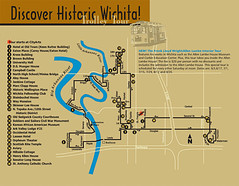When building the transit brand is compromised
Recent reports that public transit systems receiving federal funds can no longer provide shuttle and other charter services in the Washington Post, "New Rules Close Doors On Metro Shuttle Buses: Service Ends for Redskins Fans, Students on Field Trips," and in the Wichita Eagle, "Couple pick up city's historic trolley tour," indicate an overly narrow focus on what transit systems could or should do.
From the Post article:
Under Federal Transit Administration regulations that became final May 1, public agencies cannot operate charter bus service if private companies are available to provide the service. Last year, Metro chartered nearly 2,500 buses for revenue of $1.6 million.
Without a waiver from the FTA, Metro cannot provide charter service unless it first checks with dozens of charter bus companies in the Washington region, a time-consuming task that would require Metro to send e-mails to every motorcoach company registered in a regional database, officials said.
"This rule, quite effectively, takes Metro out of the business of providing charter bus service," Catoe said during a Metro board meeting.
The ban has little financial impact on Metro. Metro's fees of $310.50 per bus for a minimum of three hours and $207 per bus for schools cover direct costs and overhead and allow for "a small profit," Catoe said. The concern, he said, is the inconvenience to customers and the non-Metro buses that would drive through Metro stations.
I undertand that the federal government doesn't want government services to crowd out private business. At the same time, if you want people to use transit, in a world where most mobility still occurs via privately owned automobiles, charter services for students, and special bus services between subway stations, arenas, and concert sites (etc.) are important opportunities to deliver transit service to people who may not otherwise use it, providing a means to introduce transit services to new market segments, and to strengthen the understanding of the transit system brand within a region.
The Wichita story is particularly "sad," because to market the city, the City of Wichita has introduced and produced a number of regular tours of the city, which it delivers through the public transit system.
The creation of the tours is really a forward step--rather than wait around for others to do it (in a time when people still don't favor urban living), the city did it, and in a manner that also introduces transit to people less likely to use it or have experience with it. Now they have to turn over part of this tour experience to the private sector, which may not make sense.

From a City of Wichita press release:
This season’s Discover Historic Wichita Trolley Tours help officially kick off a summer of historic tours through downtown. These tours help Wichitans learn more about their city, and educate visitors on Wichita’s rich history. The concept was developed from the Strategic Master Plan for Tourism to enhance the visitor experience as well as provide residents the opportunity to learn more about Wichita.
One change to this year’s tours is the fact that they now depart from CityArts, located in Old Town Square at 334 N. Mead. ... The main tours will still cover the same amount of time, approximately 1-½ hour tour, and the same amount of historic buildings in Wichita, at 30 different locations.
Local volunteer and historian, Sharon Mallory, helped develop the program and personally researched and scripted each tour, as well as trained each docent to make the experience of stepping back in time more realistic. "Wichita’s history is incredible and many people do not know it. Even if they have lived here all of their life, they simply do not know Wichita’s rich history," said Mallory. "I want to make sure our heritage continues to live on and with each tour, I’m giving them a piece of it to carry on," she said.
This is the fifth year for trolley tours. New this year is the addition of three theme tours that focus on Public Art; Proudfoot, Bird & Wright Architectural Tour; and Frank Lloyd Wright/Allen Lamb Interior Tour. Each tour will follow the theme that the name suggests. The FLW/Allen Lambe Tour includes a stop at the famous architect’s home and a full tour. That particular tour includes the museum’s admission in the price so the charge is $18 for adults. Additional theme tours that returned this year are the Outdoor Sculpture Tour and Architectural Tour. All theme tours are given on alternate Saturdays at noon.
--------
Note that the CityArts facility in Wichita is interesting too.



0 Comments:
Post a Comment
<< Home